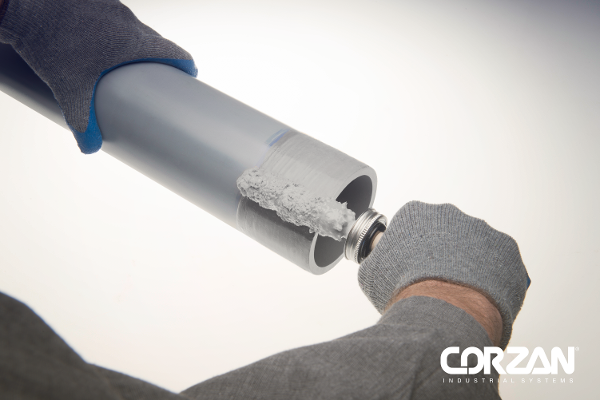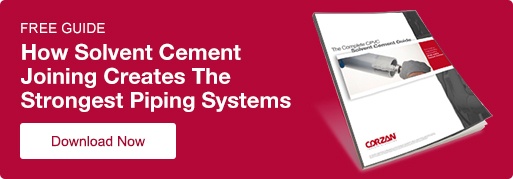What You Need to Know About CPVC Solvent Cement Cure Times
By: Jorge Solorio
Solvent cement is the recommended joining method for many industrial CPVC systems. These solutions use a combination of solvents and resin to fuse the polymer chains of two CPVC pieces.
When solvents and resin are used to unbind and then fuse the molecules of any thermoplastic material, the newly formed joint needs time to dry and harden. This process is referred to as curing.
If the system isn’t given time to fully cure, weak joints can cause issues within a system, specifically leaks.
So, what does it mean for a CPVC schedule 40 or schedule 80 piping joint or CPVC duct joint to be fully cured, and how long does that process take?
What Happens During Solvent Cement Welding?
-1.png?width=488&name=Apply-Solvent-Cement-Outside-Pip%20(2)-1.png)
Solvent cement is comprised of solvents and resins. The ratio of solvent to resin varies, and determines the cement’s viscosity.
For example, industrial applications and/or large pipe sizes require higher viscosity (also known as heavy bodied) cements, which contain more resin and less solvent when compared to regular bodied solutions.
When applied to the two surfaces to be joined, the solvents soften and dissolve the top layer of the CPVC material, unbinding its molecular structure. As the two pieces are pressed together, the loose molecules bind together. The resin is pushed into any gaps that exist within the joint, filling any voids between the two pieces. This process is aided by the use of a fitting with an interference fit. These are fittings with tapered sockets.
The newly fused CPVC molecules harden as the solvent flashes off, or evaporates. When all the solvent is gone, the joint is considered fully cured, and you’re left with one uniform piece of CPVC. The joint then assumes most of the same characteristics and strength of the original pieces of material.
The Variables That Affect Cure Time
Curing refers to a material having reached its fullest strength. Solvent cement cure times are heavily affected by pipe size, temperature and relative humidity. Some joints can cure in as little as 15 minutes, while others could take up to 48 hours. Always consult solvent cement manufacturer's guidelines. The factors that can affect the curing time of CPVC cement include pipe size, temperature and relative humidity. Tightness of fit and appropriate application of solvent cement also play a role.
Note: Corzan® Industrial Systems always recommends checking the solvent cement manufacturer’s label for recommended cure times.
Pipe Size and Application
Pipe diameter, duct dimension and application are the primary factors that determine the type of solvent cement required to properly weld a joint.
Regular bodied solvent cements tend to flash off faster than a heavy bodied solvent cement. Reason being, the additional resin in heavy bodied solvent cements slows down the rate in which the solvents can migrate out of the solution.
For larger pipe diameters (6 or more inches), ducting (minimum socket depth of 3-inches) and industrial processes, a heavy-bodied solvent cement is required to ensure a strong weld. Consequently, the cure times for these unions are greater.
Environmental Temperature
Evaporation occurs when molecules within a fluid escape. The rate of this escape increases as the molecules heat up and move around faster. This same process happens to the solvent molecules within solvent cement as it flashes out of the joint.
In warmer environments, the solvent will flash off more quickly than a similar joint exposed to colder conditions. As temperatures go up, cure times often decrease.
Humidity
Humidity also plays a role in cure times, as the evaporating solvent molecules need space within the air to go. The more humid the environment, the more densely populated the air is with water vapor, leaving less room for solvents.
Alternatively, dry settings enable faster cure times because the air has a greater capacity to accept the solvent.
The degree to which humidity affects cure times is hard to measure, but Corzan Industrial Systems recommends adding 50% to the recommended cure times in damp or humid situations.
Milestones of Solvent Cement Welding
When a joint is completely cured, virtually all the solvent has left the joint, and it takes on the characteristics and qualities of the CPVC material. However, from an installation perspective, there are a couple other intermediate milestones of which to be aware.
Avoiding Push-Out
In the case of pipes and fittings, the fitting is tapered slightly at the end, which can cause the pipe to push-out initially. Once the joint is set, it will hold itself together without any assistance.
For small piping and ducting, holding the joint together with your hands for a few seconds may be all that’s needed. Larger pipe or ducts may call for the support of a come-a-long, which mechanically holds the two pieces of CPVC together.
Set Time
Set time is the time required before the joint can be handled. Following are suggested set times for pipe and fittings at different temperature ranges.

Pressure Testing
Depending on the pipe size, temperature and application, you can begin pressure testing a system before the joint has fully cured.
The following table shows how soon after joint assembly the system can be pressurized based on pipe size, temperature and the amount of pressure in the system.
It’s always recommended to speak with our product and engineering team about your application before deciding when to start pressure testing.

Complete Cure Time
Once completely cured, the solvent has evaporated entirely, and the joint becomes a continuous piece of CPVC.
The system can now be run at maximum pressure, as the joints meet, or exceed, the pressure rating of the entire system.
We recommend talking with our product and engineering team about your industrial system and environment before installation to ensure the proper set, pressure testing and cure times.
Want to Learn More About Utilizing CPVC and Solvent Cement in Your Facility?
To ensure you choose the correct solvent cement and designate the appropriate set and cure times, contact our team of product and engineering experts. We are happy to schedule a demonstration or training session for you and your team.


